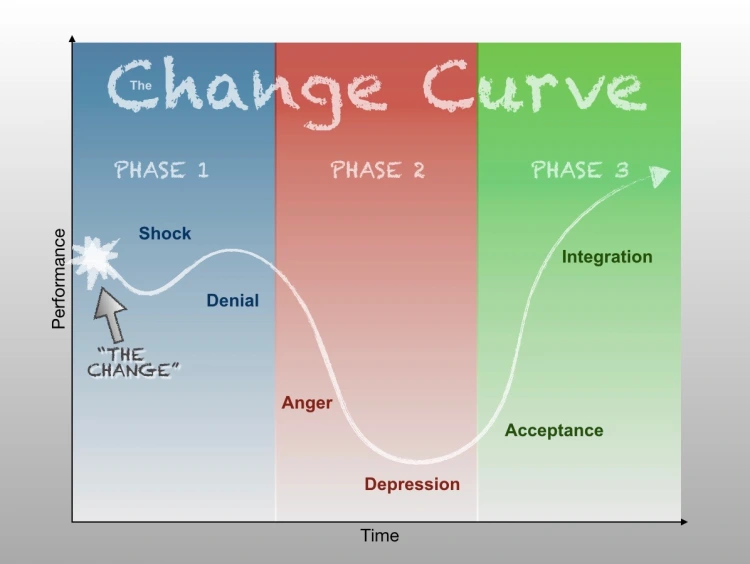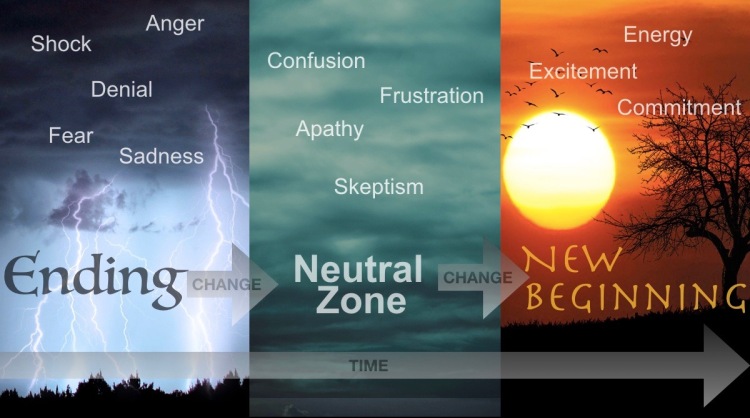![]()
Leading and managing change can often be difficult, whether that be with volunteers giving up their free time at a local sports club, professional athletes who are representing their country, or an executive workforce employed within a multinational corporation.
Many of us find change uncomfortable, and consequently our initial reaction is usually to resist and oppose it.
So if you’re looking to initiate change within your club, organisation or workplace, it’s important to understand how people will likely feel during this transition, so that you can best support and guide them through the process until they finally accept and embrace the change.
To help develop this understanding, William Bridges created The Transition Model, documented in his 1991 book, “Managing Transitions”.
As Bridges puts it…
“Transition is the inner psychological process that people go through as they internalise and come to terms with the new situation that the change brings about.
The starting point for dealing with transition is not the outcome but the endings that people have in leaving the old situation behind.
Getting people through transition is essential if the change is actually to work as planned.”
Put another way, change is something that happens to us, irrespective of agreeing to it or not, whereas transition is how we interpret this change. In other words, our thoughts, feelings, and actions in response to it.
When leaders of change, sometimes referred to as change agents, manage their followers effectively and skilfully, they are better able to manage the process efficiently and successfully.
The Transition Model is aligned with the majority of bereavement theories, which tend to follow the RAWA process…
Rejection → Anger → Withdrawal → Acceptance
One such bereavement theory is The Five Stages of Grief model (Kübler-Ross, 1969), which illustrates how we’re affected by dramatic life events…

The Change Curve, which is based on Kübler-Ross’s model, can also be used as a method for helping us to understand how people react to significant change or upheaval. Consequently, the curve can be used to predict how performance is likely to be affected by the announcement and subsequent implementation of significant change.
There are numerous variations of The Change Curve, although most use the same group of emotions which are separated into three distinct transitional phases…
Phase 1: Shock & Denial
Phase 2: Anger & Depression
Phase 3: Acceptance & Integration

Like the curve, The Transition Model has three phases, although these are described by Bridges as…
Phase 1: Ending
Phase 2: Neutral Zone
Phase 3: New Beginning

Phase 1: Ending
“What we call the beginning is often the end, and to make an end is to make a beginning. The end is where we start from.” – T.S.Eliot
To implement change, we first need to let people know that something is going to end, so this is the first phase of transition.
We naturally fear what we don’t understand, so initially this is often a time of resistance and emotional upheaval, particularly as people are being forced to let go of something that they’re probably comfortable with.
It’s thereby essential to give people time to process the news, and acknowledge and accept their reactions, which are likely to include emotions such as fear, anger, shock, denial, and sadness.
Transparency about what’s going to change and how they’ll be affected is also key, so open communication and empathetic listening is a must.
To help people further accept change, it can also be highly efficacious to symbolically mark the end of something. For example, Xerox did this by gathering their workforce to a dramatic presentation where they witnessed one of the company’s products being smashed to smithereens with a sledgehammer on stage. The debris was then collected up and taken away, followed by a spectacular unveiling of a new product, complete with pyrotechnics and uplifting music. This symbolic and visceral performance left the employees in no doubt whatsoever that the shattered product was now history, whilst a sense of excitement quickly grew about its replacement model.
Phase 2: Neutral Zone
“The essence of life takes place in the neutral zone phase of transition. It is in that interim spaciousness that all possibilities, creativity and innovative ideas can come to life and flourish.” – Susan Bridges
This second phase bridges a connection between the old and the new, so people tend to experience feelings of confusion, skepticism, frustration, and perhaps even apathy.
Yet this is frequently a time of great creativity and innovation, which thus needs to be fully encouraged and celebrated.
As people are likely to feel a little lost or uncertain during this period, they need to be given a clear sense of direction with lots of clean feedback provided. Small and frequent goals to aim for can also provide them with quick wins to improve and sustain motivation.
Furthermore, normalising as many things as possible can help to develop a sense of stability and consistency.
Phase 3: New Beginnings
“And suddenly you know: It’s time to start something new and trust the magic of beginnings.” – Meister Eckhart
The final phase is one of high energy, acceptance, and excitement, with followers being more receptive to learning and committing to the change.
Accordingly, it’s advantageous now to provide support and training to help them sustain this mindset, as well as aligning their personal goals with the objectives of the club or organisation.
Change is rarely an easy process, so this is an ideal time to celebrate all that everyone’s gone through, highlighting any success stories, and rewarding people for their hard work.
However, take care to avoid complacency by appreciating that not everyone will have entered this final phase yet and this can have negative consequences, such as dragging others back into the previous phases, especially if they don’t believe that the change is working.
A final thought
The most successful clubs, organisations, and companies understand why it is they do what they do. They’re able to define a cause that they truly believe in, which in turn defines their purpose. They know ‘why’ they exist. Change is an ideal time for helping people to understand why there is a need to move in a different direction.

Remember, change can be a time of worry and upheaval for many of us, so if you’re implementing change, be mindful of remaining patient with everyone, giving people the time, support and training to transition through each phase.
Do this with skill, create a collective why, and change can be a wonderful thing.
Would you like to support my writing? Click here to find out more

Thanks for the thought-provoking post! I presume the IBM presentation included and explanation of WHY the change was necessary. In my current profession, I’ve found “the why” is not explained. Which is amazing because most parents find themselves explaining “the why” with a 3 – 4 years old (that’s the favorite question at that age) but some “leaders” forget to explain it when their team is going through change. I submit that explanation facilitates get to the acceptance stage without the inner turmoil.
LikeLiked by 2 people
Yes absolutely, great point! “The Why” is essential….thanks for pointing this out 👍
LikeLiked by 1 person
That’s why I like the three w’s of change: What (has to change) Why (it has to change) How (it will change and who will be involved). I like this simple model as upfront you let people know; what has to change and why. And then you engage people in helping you implement the change, by involving them in how the changes can be achieved.
LikeLiked by 3 people
Very good, like this!
LikeLiked by 1 person
Hi Nathan, thank you: I enjoy reading your blog posts.
LikeLiked by 1 person
Another great post with fantastic insights. I always enjoy reading your posts and I’m certain this one will be handy back in the office on Monday morning. Thanks!
LikeLiked by 1 person
Thank you too, comments like these make it all the worthwhile!
LikeLiked by 1 person
This is so funny, we just went over these ideas in class this week. To see them being used in the really world helps understand there value a ton. Love reading your posts.
LikeLiked by 1 person
Great to hear and thanks for your comments!
LikeLike
I love your blog and wanted to let you know that I’ve nominated you for the Mystery Blogger Award (link below!). You’re awesome and I can’t wait to read your next post!
http://thecheekycyclist.com/2018/01/19/cheekys-first-mystery-blogger-award/
LikeLiked by 1 person
Wow thanks….very honoured and humbled!
LikeLiked by 1 person
Wow! So informative its like reading an article in the HBR. Thank you.
LikeLiked by 1 person
Thanks Jay, appreciate your comments!
LikeLike
Yes.. Success lies beyond our comfort zones… Very informative and engaging post
LikeLiked by 1 person
Thank you 🙏
LikeLike
A little late this but I forgot to mention the ADKAR change model. I have worked with this before and like it. You can read more about it here. https://www.prosci.com/adkar/adkar-model
LikeLike
Very informative. Thank you.
LikeLiked by 1 person
I really enjoyed reading it
LikeLiked by 1 person
This has fit like a glove…how did you know I am going through one? Haha thank you!
LikeLiked by 1 person
Haha intuition! Good luck 👍
LikeLike
Really enjoyed reading your blog. 👍
LikeLiked by 1 person
Thank you 🙏
LikeLike
Welcome 😊
LikeLike
This is a very timely and informative post. Have been looking for something to share with my team and this is perfect.
LikeLiked by 1 person
Thanks, and hope it goes well!
LikeLiked by 1 person
This is actually very helpful. I’ve always been terrible with change, and much moreso as I age, but distinguishing between change and transition could be quite productive.
The Kubler-Ross study was actually with patients who were terminally ill, but it has been commonly applied to grief more recently. I actually haven’t encountered many people who seem to grieve in those stages, to be honest. I wonder if the stages reveal themselves when someone is more personally involved in a change: of job, of wealth, of life, etc.
LikeLiked by 1 person
The 2009 TED talks offered Simon Sineck, who promoted the golden circle, and I was surprised at how many business people worked backwards.
I started in marketing (sales) in 1975, and took to it like a fish in water, a bird in flight, and a bull heading down to the range. I mastered product knowledge early on, and then worked on studying peoples hot buttons. And I set a lot of records. Yet one day, as my ego was stroking me at the branch I worked out of, my Mgr called me to meet the VP of sales, who asked me what the most important thing about our business was.
I said that’s easy, ask for the sale. And they both laughed.
After the VP left that afternoon, my Mgr asked me if I knew why they thought I missed the mark, and I said no.
He said, ‘because nobody cares how much you know, until they know how much you care’.
And I have lived by that credo all of my life…by the way, I drew my circle of life in 2005. But I still liked Simon’s talk.
Thank you for liking my work as well.
LikeLiked by 1 person